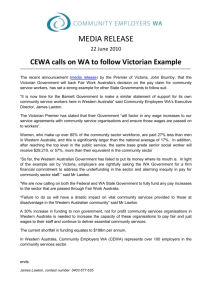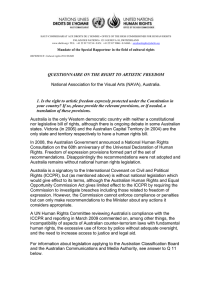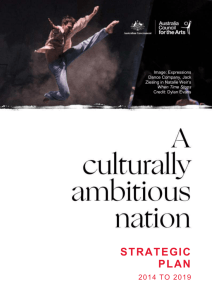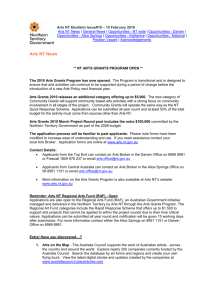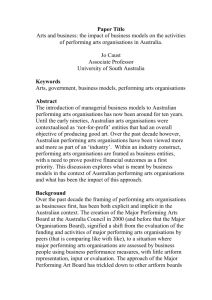Accessible Version - Australia Council for the Arts
advertisement
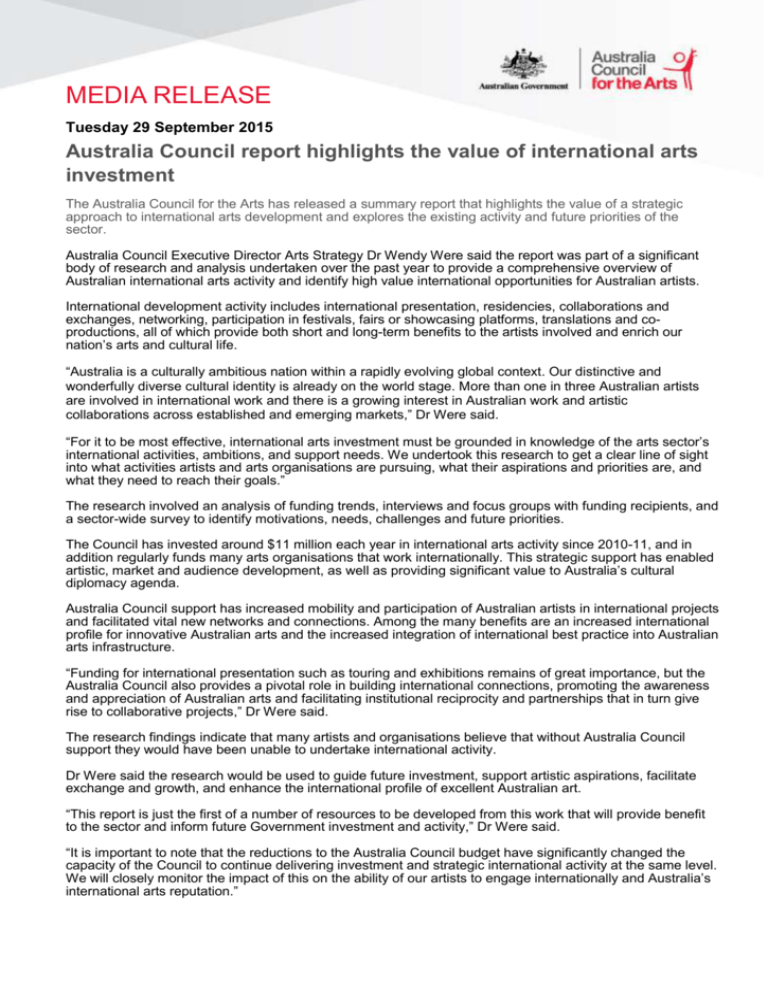
MEDIA RELEASE Tuesday 29 September 2015 Australia Council report highlights the value of international arts investment The Australia Council for the Arts has released a summary report that highlights the value of a strategic approach to international arts development and explores the existing activity and future priorities of the sector. Australia Council Executive Director Arts Strategy Dr Wendy Were said the report was part of a significant body of research and analysis undertaken over the past year to provide a comprehensive overview of Australian international arts activity and identify high value international opportunities for Australian artists. International development activity includes international presentation, residencies, collaborations and exchanges, networking, participation in festivals, fairs or showcasing platforms, translations and coproductions, all of which provide both short and long-term benefits to the artists involved and enrich our nation’s arts and cultural life. “Australia is a culturally ambitious nation within a rapidly evolving global context. Our distinctive and wonderfully diverse cultural identity is already on the world stage. More than one in three Australian artists are involved in international work and there is a growing interest in Australian work and artistic collaborations across established and emerging markets,” Dr Were said. “For it to be most effective, international arts investment must be grounded in knowledge of the arts sector’s international activities, ambitions, and support needs. We undertook this research to get a clear line of sight into what activities artists and arts organisations are pursuing, what their aspirations and priorities are, and what they need to reach their goals.” The research involved an analysis of funding trends, interviews and focus groups with funding recipients, and a sector-wide survey to identify motivations, needs, challenges and future priorities. The Council has invested around $11 million each year in international arts activity since 2010-11, and in addition regularly funds many arts organisations that work internationally. This strategic support has enabled artistic, market and audience development, as well as providing significant value to Australia’s cultural diplomacy agenda. Australia Council support has increased mobility and participation of Australian artists in international projects and facilitated vital new networks and connections. Among the many benefits are an increased international profile for innovative Australian arts and the increased integration of international best practice into Australian arts infrastructure. “Funding for international presentation such as touring and exhibitions remains of great importance, but the Australia Council also provides a pivotal role in building international connections, promoting the awareness and appreciation of Australian arts and facilitating institutional reciprocity and partnerships that in turn give rise to collaborative projects,” Dr Were said. The research findings indicate that many artists and organisations believe that without Australia Council support they would have been unable to undertake international activity. Dr Were said the research would be used to guide future investment, support artistic aspirations, facilitate exchange and growth, and enhance the international profile of excellent Australian art. “This report is just the first of a number of resources to be developed from this work that will provide benefit to the sector and inform future Government investment and activity,” Dr Were said. “It is important to note that the reductions to the Australia Council budget have significantly changed the capacity of the Council to continue delivering investment and strategic international activity at the same level. We will closely monitor the impact of this on the ability of our artists to engage internationally and Australia’s international arts reputation.” The key findings include: Most funding applications were for activities in the established markets of Western Europe and North America; however, grants and applications for activity in Asia have increased 65 per cent over the past four years. The majority of grants for international activity went to independent groups and individuals. Of Council’s regularly funded organisations, 43 per cent had engaged in international activity, including 13 of the 28 Major Performing Arts companies and 66 of the 157 Key Organisations. During 2010-13 regularly funded organisations presented 3,800 performances and 4,473 days of exhibitions across 61 countries, which were seen by about 17.9 million people. Maintaining activity in established markets and increasing activity in growth markets is already happening. Artists and arts organisations would like to see the Council continue to promote Australian artists and art abroad, helping them tap into growth markets, supporting diverse work and long-term engagements and ensuring flexible quick response funding. International engagement is motivated by development of artistic practice, audiences and markets. Benefits include participation in the international arts sphere, artistic and market development, and future international projects. Artists and arts organisations are increasingly looking for collaborations and exchange projects. These partnerships and reciprocal programs will continue to be a priority over the next five years. To read the report, go to: http://www.australiacouncil.gov.au/research/publications/ Karen Smith Media Manager, Australia Council for the Arts 02 9215 9030 | 0498 123 541 k.smith@australiacouncil.gov.au





